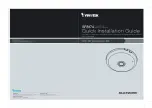
© BECOM Systems 2020
34
|
58
Software User Manual - Argos3D - P33x
Last change: 29 June 2020/Version 10
4.10
Sequencing
The Argos3D - P33x allows the configuration of up to 4 sequences on the TIM. These sequences are captured
immediately after each other by the TIM. Each sequence can be configured with individual integration time and
modulation frequency.
If the camera’s video mode is disabled (see register
Mode0
), and the camera is manually triggered, each trigger
will generate as many sequences as currently configured.
The number of sequences can be configured in register
NofSequ
.
For sequence 0, use registers
IntegrationTime
and
ModulationFrequency
to set integration time and
modulation frequency, respectively.
For sequence 1, use registers
IntTimeSeq1
and
ModFreqSeq1
.
For sequence 2, use registers
IntTimeSeq2
and
ModFreqSeq2
.
For sequence 3, use registers
IntTimeSeq3
and
ModFreqSeq3
.
Each sequence is processed and streamed by the camera as one individual frame. Each frame header contains the
sequence number in field
SequenceNumber
.
4.11
Illumination Pre-Heating
The camera supports pre-heating of the LEDs on the LIMs immediately before capturing. Pre-heating is
accomplished by applying the modulation signal to the LEDs prior to starting exposure of the ToF sensor.
Separate pre-heating times can be set for the first phase after a trigger and all consecutive phases.
For setting the pre-heating time for the first phase after a trigger, use register
IllPreheatingTime
(in
microseconds).
For setting the pre-heating time for consecutive phases, use register
IllPreheatingTimeConsecutive
(in
microseconds).
4.12
Distance Offset Calibration
Each Argos3D - P33x is offset-calibrated out of factory.
For each pre-defined modulation frequency, there is an absolute offset in millimeters that all distance values are
corrected with. The absolute offsets are stored in registers
DistOffset0
(for 5 MHz modulation frequency) to
DistOffset11
(for 80 MHz). Offsets can be modified by direct register writes.
Distance Offset correction is enabled or disabled in register
ImgProcConfig
.
The camera has also a built-in offset calibration function, which is described in the following procedure. You let
the camera know the real distance and the camera will calculate the correct absolute offset. It uses a square of
4x4 pixels in the center of the distance image.
















































